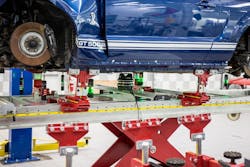Electronic measuring systems provide an accurate baseline for the repair process, often finding hidden damage that would go unnoticed using traditional measuring methods.
The data provided by the systems is becoming increasingly crucial to successful repairs, especially as new vehicle launches or engineering changes increase in frequency and data becomes more valuable to shops, says I-CAR’s Jason Bartanen.
A collision can affect a vehicle’s structure in three directions—height, width and length—and because of that, a vehicle must be measured in all three directions, often referred to as 3-D measuring. Modern measuring systems can also give instant feedback during the repair process itself. Using an electronic measuring system, Bartanen says, is a must in today’s industry.
But shops need to carefully analyze options before making a decision, because the equipment could be in a facility for a lifetime. There are a number of factors that should be considered before making the purchase.
Understand your shop’s needs.
For example, what is your vehicle mix? If it’s more varied, you may want a system that is adaptable for the majority of makes and models. If you’re on a certification program or looking to join one, you will want to research any requirements or OEM-approved systems.
Also, consider during which part of the repair process you plan to use the system. Bartanen says many shops utilize the system during blueprinting, in addition to during the straightening process and final verification. Most electronic measuring systems do provide before-and-after print-outs, which Bartanen says can be helpful during conversations with customers and insurance companies.
Finally, each system requires either a two- or four-post lift or a frame rack or bench, which could be another expense for the shop.
Know the technology.
There are different types of technology used by the various systems to measure the damage: lasers, ultrasound, and a digital measuring arm and slide.
“They’re all going to give you that three-dimensional measuring information that you need to ensure that the dimensions are restored properly,” Bartanen says. “It’s just a different type of technology.”
The laser measuring systems, for example, use battery-powered targets hung in specified locations on the underside. A laser scanner that sits on a tripod sweeps the measurement area and each measurement is color-coded back on the computer monitor to show the severity of the damage.
The ultrasound systems, such as Blackhawk Shark and Tru-Point Sonic 360, utilize emitter probes attached to specified points on the vehicle, which simultaneously send signals to high-frequency microphones located in an extruded aluminum beam and are then transmitted to a computer system.
Finally, the point system uses a digital measuring arm that either glides on the underside of the vehicle or is manually moved to make specific measurements along the vehicle. Various types of technology, including Bluetooth, are used with these systems.
Have the right data source.
The standard go-to for shops should be OEM-build data, and the repair information those automakers provide, Bartanen says, which is what the majority of the systems utilize. Build data from OEMs provides the original specs of a vehicle, as it would come off the assembly line.
Some system manufacturers, such as Chief, however, have built their own repair data database, measuring every available vehicle on a lift and adjusting the benchmark specs to reflect the conditions the average shop would see when measuring. While OEM-build data allows for a threshold on slight variances in the measurements, it doesn’t necessarily provide a “real-world” benchmark for shops, whereas Chief says its benchmarks give added accuracy for the repair process.
Provide training.
Bartanen stresses that quality training and local support is imperative to correctly implementing an electronic measuring system.
“If you have questions about how to use the equipment properly, you want to make sure you have someone you can call on and be available at your facility,” he says. “Training is important to make sure you have the right equipment, how to set it up, how to use it, scheduled maintenance.”
The Systems
FenderBender took a look at the systems that produce full-body reports, along with their respective capabilities, data sources, cost, and set-up and reading times
